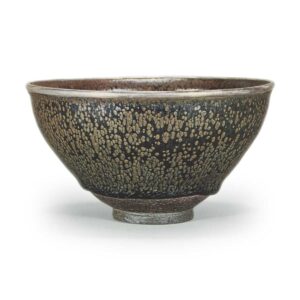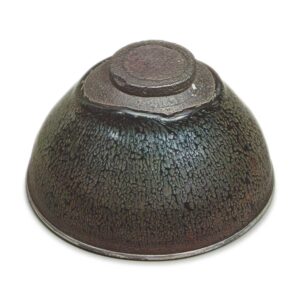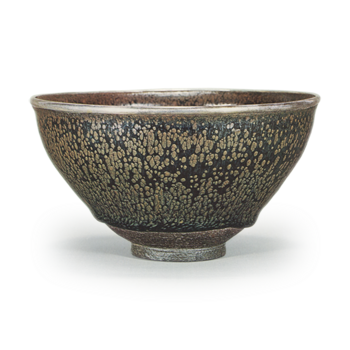

Height: 6.7cm
Diameter: 12.0cm
Outer diameter of foot: 3.9cm
Height of foot: 0.5cm
When we talk about Yuteki Tenmoku, we usually refer to tea bowls with a jet-black glaze and beautifully scattered round spots of silver-iron color, but among the tea bowls that have been called Yohen or Yuteki since ancient times, there are quite a few that cannot be called Yohen or Yuteki by today’s strict standards, as can be seen in the “Taisho As can be seen from the examples listed in the Taisho Kikikan (A Guide to Each Vessel), there are quite a few examples that cannot be called yohen or yudeki using today’s strict criteria, and the classification of kitenmoku and haikyotenmoku is also quite ambiguous. This was inevitable in the past, when there was no way to bring together and compare them as we can today, and it is telling that there were many cases where tea masters who did not know the standard examples judged them to be Yohen or Yuiteki based on oral tradition or hearsay. In this context, the Yuteki bowls that came from the Matsudaira Fumai family, the Sakai family, and the Kuroda family can be said to be first-class Kenzan Yuteki Tenmoku bowls, even in a strictly regulated environment.
The dignified shape of the bowl is similar to the Yuteki bowl from the Fumai family, and the dignified, silver Yuteki spots are quite large, similar to the Yuteki bowl from the Sakai family. However, while the Matsudaira and Sakai families both have oil spots that clearly stand out against the jet-black ground glaze, this tea bowl has a large area near the rim that has turned a persimmon color, which somewhat detracts from the brilliance of the oil spots. However, the beauty of the bluish mottled pattern that appears around the base is peerless, and the thick glaze pooling at the base is also magnificent. The rim is silver-rimmed.
The inside of the bowl is also iridescent, with a bluish hue around the center and a slightly reddish hue around the rim.
The foot of the bowl is carved in the distinctive Tekkan style, and the clay is slightly reddish. It is a shame that there is a chip the size of a grain of rice on the tatami mat.
It is accompanied by a black lacquered Amagasaki stand, and on the front of the black lacquered inner box lid, there are four characters in gold powder form that read “Yudeki Tenmoku”, but the author is unknown. It is not included in the “Taisho Meiki Kan” (Great Taisho Masterpieces), but when it was in the possession of the Kuroda family, it was designated as an Important Art Object.
It is not clear why such a famous bowl was not included in the Taisho Meiki Kan, but since Tenmoku tea bowls were not highly prized in the world of tea ceremony after the Momoyama period, it seems that there are many famous bowls that should be highly valued that remain unrecognized, both in the Taisho Meiki Kan era and today.
It is not known today when this tea bowl, which has been passed down in the Kuroda family, became a family heirloom, but it is certain that it has been in the family since the Higashiyama period.
It is not known when it left the Kuroda family.



